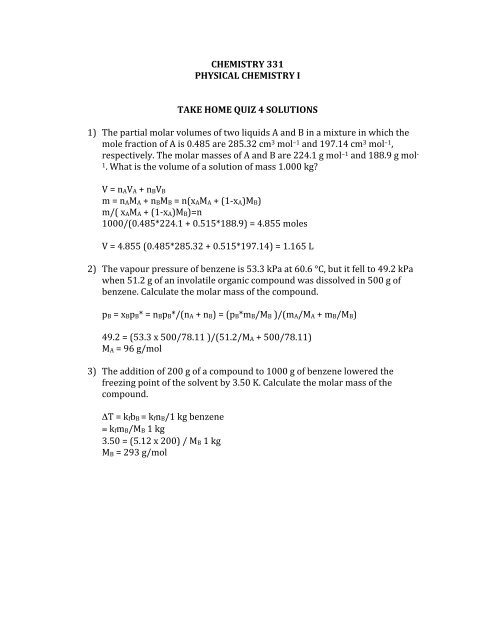CHEMISTRY 331 PHYSICAL CHEMISTRY I TAKE HOME QUIZ 4 ...
CHEMISTRY 331 PHYSICAL CHEMISTRY I TAKE HOME QUIZ 4 ...
CHEMISTRY 331 PHYSICAL CHEMISTRY I TAKE HOME QUIZ 4 ...
- TAGS
- quiz
- mason.gmu.edu
Create successful ePaper yourself
Turn your PDF publications into a flip-book with our unique Google optimized e-Paper software.
<br />
<br />
<strong>CHEMISTRY</strong> <strong>331</strong> <br />
<strong>PHYSICAL</strong> <strong>CHEMISTRY</strong> I <br />
<br />
<br />
<strong>TAKE</strong> <strong>HOME</strong> <strong>QUIZ</strong> 4 SOLUTIONS <br />
1) The partial molar volumes of two liquids A and B in a mixture in which the <br />
mole fraction of A is 0.485 are 285.32 cm 3 mol –1 and 197.14 cm 3 mol –1 , <br />
respectively. The molar masses of A and B are 224.1 g mol –1 and 188.9 g mol ‐<br />
1 . What is the volume of a solution of mass 1.000 kg? <br />
V = nAVA + nBVB <br />
m = nAMA + nBMB = n(xAMA + (1‐xA)MB) <br />
m/( xAMA + (1‐xA)MB)=n <br />
1000/(0.485*224.1 + 0.515*188.9) = 4.855 moles <br />
<br />
V = 4.855 (0.485*285.32 + 0.515*197.14) = 1.165 L <br />
<br />
2) The vapour pressure of benzene is 53.3 kPa at 60.6 °C, but it fell to 49.2 kPa <br />
when 51.2 g of an involatile organic compound was dissolved in 500 g of <br />
benzene. Calculate the molar mass of the compound. <br />
<br />
pB = xBpB* = nBpB*/(nA + nB) = (pB*mB/MB )/(mA/MA + mB/MB) <br />
<br />
49.2 = (53.3 x 500/78.11 )/(51.2/MA + 500/78.11) <br />
MA = 96 g/mol <br />
<br />
3) The addition of 200 g of a compound to 1000 g of benzene lowered the <br />
freezing point of the solvent by 3.50 K. Calculate the molar mass of the <br />
compound. <br />
<br />
ΔT = kfbB = kfnB/1 kg benzene <br />
= kfmB/MB 1 kg <br />
3.50 = (5.12 x 200) / MB 1 kg <br />
MB = 293 g/mol <br />
<br />
<br />
<br />
<br />
<br />
<br />
<br />
<br />
<br />
<br />
<br />
<br />
<br />
4) Consider a container of volume 2.0 dm 3 <br />
that is divided into two <br />
compartments of equal size. In the left compartment there is nitrogen at 1.0 <br />
atm and 25 °C; in the right compartment there is oxygen at the same <br />
temperature and pressure. Calculate the entropy and Gibbs energy of mixing <br />
when the partition is removed. Assume that the gases are perfect. <br />
ΔG = nRT (xAlnxA + xBlnxB) = pV (xAlnxA + xBlnxB) <br />
= 101.3 x 10 3 (2.0 x 10 ‐3 ) (0.5 ln0.5 + 0.5 ln0.5) <br />
= ‐140 J <br />
<br />
ΔS = ‐ΔG/T = ‐140 / 298 = 0.471 J K ‐1 <br />
5) Given that p*(H2O) = 0.02308 atm and p(H2O) = 0.02171 atm in a solution in <br />
which 0.207 kg of a non‐volatile solute (M = 298 g mol –1 ) is dissolved in <br />
0.892 kg water at 293 K, calculate the activity and activity coefficient of <br />
water in the solution. <br />
aA = pA/pA* = 0.02171/0.02308 = 0.9406 <br />
<br />
gA = aA / xA = aA (nA + nB)/nA <br />
= 0.9406 (892/18 + 207/298) / (892/18) = 0.954

















